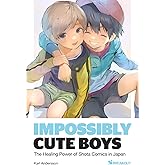
Download the free Kindle app and start reading Kindle books instantly on your smartphone, tablet, or computer - no Kindle device required.
Read instantly on your browser with Kindle for Web.
Using your mobile phone camera - scan the code below and download the Kindle app.

Male Colors: The Construction of Homosexuality in Tokugawa Japan First Edition
Combing through popular fiction, law codes, religious works, medical treatises, biographical material, and artistic treatments, Leupp traces the origins of pre-Tokugawa homosexual traditions among monks and samurai, then describes the emergence of homosexual practices among commoners in Tokugawa cities. He argues that it was "nurture" rather than "nature" that accounted for such conspicuous male/male sexuality and that bisexuality was more prevalent than homosexuality. Detailed, thorough, and very readable, this study is the first in English or Japanese to address so comprehensively one of the most complex and intriguing aspects of Japanese history.
- ISBN-100520086279
- ISBN-13978-0520086272
- EditionFirst Edition
- PublisherUniversity of California Press
- Publication dateJanuary 31, 1996
- LanguageEnglish
- Dimensions6.5 x 1 x 9.5 inches
- Print length317 pages
Customers who viewed this item also viewed
Editorial Reviews
From the Inside Flap
"Opens a window on the complex and varied patterns of sexual relations between males in early modern Japan. Imperative reading for anyone concerned with human sexual expression in social context."David F. Greenberg, author of The Construction of Homosexuality
"Nanshokumale colorsas male same-sex eroticism and sexuality were known in early modern Japan, enjoyed an honored place in the life and mythology of the age, celebrated in art and literature with as much energy and enthusiasm as male-female eroticism. Unfettered by the moral opporbium that constrainedor concealedmale-male eroticism in Europe, male colors flew brightly in the public culture of urban Japan. Gary Leupp explores the practices and the cultural celebration of the Edo-era nanshoku tradition in this exuberant, sensitive, and yet dispassionate social and cultural history of male homoeroticism, the best modern scholarly study in English to date. Leupp ranges widely in a vast array of original literary, dramatic, and visual sources, which he brings to life with a finely textured use of comparative material from other traditions of male-male love both in East Asia and across the premodern world. Highly original and insightful, it will be standard reading for years to come."Ronald P. Toby, author of State and Diplomacy in Early Modern Japan: Asia in the Development of the Tokugawa Bakufu
From the Back Cover
About the Author
Product details
- Publisher : University of California Press; First Edition (January 31, 1996)
- Language : English
- Hardcover : 317 pages
- ISBN-10 : 0520086279
- ISBN-13 : 978-0520086272
- Item Weight : 1.15 pounds
- Dimensions : 6.5 x 1 x 9.5 inches
- Best Sellers Rank: #4,261,625 in Books (See Top 100 in Books)
- #5,337 in Japanese History (Books)
- #6,695 in LGBTQ+ Demographic Studies
- #9,078 in General Gender Studies
- Customer Reviews:
About the author

Discover more of the author’s books, see similar authors, read book recommendations and more.
Customer reviews
Customer Reviews, including Product Star Ratings help customers to learn more about the product and decide whether it is the right product for them.
To calculate the overall star rating and percentage breakdown by star, we don’t use a simple average. Instead, our system considers things like how recent a review is and if the reviewer bought the item on Amazon. It also analyzed reviews to verify trustworthiness.
Learn more how customers reviews work on Amazon-
Top reviews
Top reviews from the United States
There was a problem filtering reviews right now. Please try again later.
However, it is a scholarly work and well-worth the price of research.
Especially since I've read and reread this book several times.
At each reading I find an answer to something I've always wondered about.
For example, why did Japanese nobility tend to be so warlike?
If a Lordling gives honors and offices to an undeserving Boy Toy.....
Well, you can imagine.
Initially, as the author describes, same-sex love in Japan was something practiced by elite groups: first the Zen Buddhist monks who are believed to have imported the practice from China (a curious notion because this also carries the connotation that homosexuality came from "some place else") and then the samuri elite. While factors such as the lack of eligible women may have contributed to the general acceptance of bisexuality, many, if not most, of the practicers of nanshoku had deep emotional ties to their partners. But as urban life began to grow, nanshoku was popularized through a combination of the kabuki theater and the commercial sex enterprises that cropped up.
Also interesting were all the examples of art depicting nanshoku, some of it quite ribald and most of it graphic. But that just lends more weight to the notion that there was no stigma attached to boy love during this period in Japan, at least not a universal stigma; it was quite nearly universally tolerated and any effort to control nanshoku usually was to control violent fights over popular boy prostitutes rather than a governmental decree against homosexual sex.
The book is heavy on male sexuality with little mention of lesbianism, but that's hardly a surprise considering most cultures tend to be strongly patriarchal and it is the men who record history. And as usual, it appears that it was through contact with the West, particularly with Christian missionaries, that the practice of nanshoku was eventually shunned into the crepuscular corners of Japanese culture. More evidence that if there is harm caused by same-sex activity, the harm is caused by a prudish societal mentality orignating in a rigid Judeo-Christian ethic that thrives on domination and guilt.


















